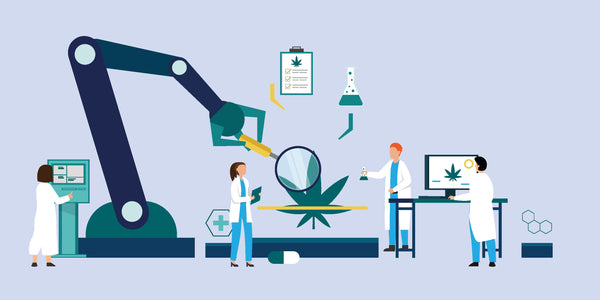From Lab to Product: The Journey of High-Quality Cannabis Extracts
Dec 16, 2024
Ever wonder how cannabis extracts go from raw plant material to the sleek, golden concentrate in your vape pen or dab rig?
The process is a delicate blend of science, craftsmanship, and precision, with every step playing an essential role in shaping the final product that consumers enjoy. From the quality of the starting cannabis material to the employment of sophisticated refinement stages, crafting high-quality extracts requires careful attention to detail—and having the right tools for the job.
Raw Material Selection and Preparation
The journey to high-quality cannabis extracts begins with exceptional raw material, whether sourced from growers or grown as a component of vertically integrated operations.
Whether you use flower or trim, the quality of your biomass plays a fundamental part in shaping your end product's potency, flavor, and marketability. Cannabinoids and terpenes—the essential compounds responsible for psychoactivity and flavor—must be carefully preserved from the very start to deliver premium results.
Using high-quality biomass in your extractions is non-negotiable if you want to produce a quality product. Cannabis material rich in cannabinoids and terpenes ensures your extraction process captures the full spectrum of desirable compounds. To achieve this, rigorous quality control is essential.
Every batch of raw material should undergo testing for potential contaminants, such as pesticides, heavy metals, and microbial agents. These tests are not just about complying with regulations—they’re about protecting the purity of the finished extract.
Equally important here is how you handle your biomass throughout the process. Proper drying and curing work to remove any excess moisture, protecting those essential cannabinoids and terpenes from the effects of degradation.
Once it’s dried, storing the material in a cool, dark, and dry environment helps maintain its chemical integrity. Then, when it’s time to extract, mill, or grind the cannabis, the surface area increases, optimizing contact with solvents or heat during processing.
Using Decarboxylation to Activate Cannabinoids
Decarboxylation is an essential step in the production of high-quality cannabis extracts that transform acidic cannabinoids like THCA and CBDA into their active forms—THC and CBD.
Activating these compounds unlocks their full potential, delivering the potency and effects that define premium cannabis extracts—skipping or mishandling this step leaves the product chemically inactive and far less effective.
Decarboxylation involves heating the raw cannabis material, causing a chemical reaction that removes a carboxyl group from the acidic cannabinoids.
Precision in temperature and timing is paramount here. Too little heat and the conversion remains incomplete; too much, and you risk degrading cannabinoids or burning off valuable terpenes that define the extract’s flavor and aroma. Thankfully, modern automated systems have made decarboxylation much more efficient and reliable.
The Different Types of Extraction Methods
Cannabis extraction methods determine the resulting concentrate's quality, texture, potency, and flavor.
Each technique has its own strengths, challenges, and applications, giving you the flexibility to produce a range of products that are adjusted to meet consumer preferences.
Solvent-Based Extraction
Hydrocarbons like butane, propane, and ethanol are widely used for their efficiency in dissolving cannabinoids and terpenes from plant material. These methods excel at creating potent, high-yield extracts suitable for various applications.
However, residual solvent removal remains a critical challenge, requiring precise post-processing to meet compliance standards. Ethanol, in particular, is often favored for its scalability and versatility.

CO2 Extraction
Pressurized carbon dioxide is a highly regarded option that particularly stands out for its ability to produce clean, solvent-free extracts. This particular method offers fine control over temperature and pressure, enabling you to capture full-spectrum profiles rich in cannabinoids and terpenes.
While CO2 extraction systems can be more expensive, they provide a cleaner, environmentally friendly option for crafting premium products.
Solventless Extraction
Classic solventless extraction methods, such as rosin pressing and hash-making, rely on heat, pressure, or mechanical separation to extract the precious cannabinoids and terpenes.
These methods are popular for their simplicity and purity. They produce clean, terpene-rich concentrates without the need for chemical solvents. While less efficient in large-scale operations, they are ideal for artisan or small-batch production.
The Importance of Filtration Media
Your choice of filtration media plays an important role in all these options and the outcomes you can expect.
Having effective filtration in your setup helps remove any undesirable plant material, waxes, and other impurities early in the process, allowing you to create cleaner and higher-quality extracts. Choosing the right extraction method and filtration approach will enable you to achieve your final product's desired potency, texture, and flavor profiles.
The Role of Filtration and Purification
Filtration and purification are the foundations for crafting clean, high-quality cannabis extracts that consumers will love and keep coming back to. These steps go beyond simply refining the product; they define its flavor, potency, and overall marketability.
Using the right filtration media ensures that every batch meets the highest standards, whether you’re producing distillates, full-spectrum concentrates, or terpene-rich live resins.
- Initial Filtration: The first step in purification targets waxes, fats, and lipids that remain after solvent-based extractions. Core processes like winterization, which involves chilling the extract and filtering out these unwanted components, rely on filtration media to achieve clarity and consistency. Removing these impurities enhances the extract’s visual appeal and prevents clogging or degradation in later stages of refinement.
- Purification Steps: Chlorophyll, particulate matter, and other impurities can compromise the flavor, color, and quality of your extract. Advanced filtration technologies eliminate these contaminants, allowing the natural profiles of cannabinoids and terpenes to shine. Precision-engineered filtration media designed for specific extraction methods helps fine-tune these processes for optimal results.
- Residual Solvent Removal: For solvent-based extractions, meeting regulatory standards for residual solvents is non-negotiable.
Technological Advancements in Filtration Media
Modern filtration materials are often customized to the unique demands that come with cannabis extraction. From specialized media that target specific impurities to scalable solutions for large production facilities, these advancements allow you to refine products with exceptional consistency and minimal waste.
Imagine starting with a cloudy, poorly filtered extract loaded with fats and residual solvents. Optimized filtration can transform that extract into a vibrant, crystal-clear concentrate—ready to command top dollar on the market. That’s exactly why mastering filtration and purification is essential to elevating your extract from acceptable to exceptional.
Refinement Techniques for Extracts
Employing different refinement techniques is critical for improving the purity, potency, and overall quality of different cannabis extracts. These secondary processes take crude extracts to the next level, creating products that meet both regulatory standards and consumer expectations.
Distillation concentrates cannabinoids with precision, separating them from residual impurities such as trace solvents. It uses heat and vacuum pressure to vaporize cannabinoids, leaving unwanted compounds behind. Distillation is important for producing THC and CBD distillates used in vape cartridges, edibles, and topicals, offering unmatched clarity and potency.
Chromatography allows for even greater precision by separating cannabinoids and terpenes at the molecular level, enabling the creation of highly specific formulations. Chromatography provides exceptional purity and consistency, whether producing full-spectrum extracts or isolating a specific cannabinoid for your products.
Winterization removes fats, waxes, and lipids left behind after extraction. Chilling the extract separates these impurities, which are then filtered out to achieve a clean, stable product. Doing so ensures that the final product has a smooth texture and improved visual appeal.
Advanced filtration media are fundamental in all these processes. Carefully engineered for compatibility with distillation, chromatography, and winterization, these materials maximize efficiency and minimize product loss.
Product Formulation and Final Testing
Transforming crude oil or purified extracts into consumer-ready products demands the highest degrees of precision and care in your work.
Extracts serve as the foundation for various applications, including vape cartridges, edibles, tinctures, topicals, and more. Each of these products requires carefully tailored formulation techniques to achieve the desired consistency, potency, and user experience that you’re looking to get. Remember that it’s crucial to retain the integrity of cannabinoids and terpenes during the formulation process.
Consumers are increasingly prioritizing elements like flavors, aromas, and effects, making it essential to preserve these compounds while maintaining uniform potency. Any adjustments in viscosity, carrier oils, or emulsifiers must complement the extract’s natural profile without degrading its quality.
Final testing is non-negotiable before your product reaches the market. Here, cannabinoid content, terpene levels, and the presence of residual solvents or contaminants undergo rigorous analysis to maintain compliance with regulatory standards and deliver the highest-quality products to consumers.
Filtration media is critical in achieving consistency and scalability during the formulation process. Precision-engineered filtration media blends help remove those unwanted impurities while stabilizing your extracts, setting the stage for uniform production at scale.

From Start to Finish, Quality Matters
Producing high-quality cannabis extracts is an incredibly complex journey that requires attention to detail at every stage, from selecting premium biomass to refining the final product.
Each step, whether decarboxylation, extraction, purification, or formulation, is responsible for delivering a clean, potent, and flavorful product to consumers. Filtration media plays an important part in this process, too, by ensuring that impurities are removed and consistency is maintained, no matter the scale of your operation.
When you're ready to advance your extraction process, Media Bros. has the expertise and solutions you need. Our line of premium filtration media and equipment is designed to help you achieve exceptional results, whether you're refining crude oil or crafting artisanal concentrates. Let us help you find the perfect filtration solution for your operation.
Contact our team at sales@mediabros.store or call 1 (503)-308-7138 to learn more about how we can support your goals and elevate your extraction process. Remember to ask about your free sample of filtration media!







